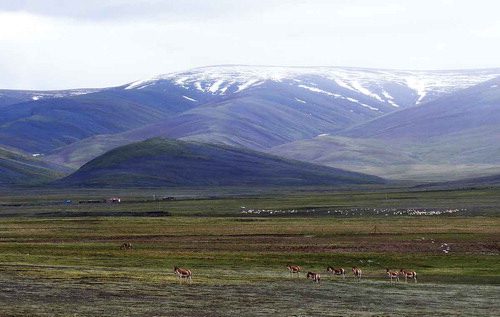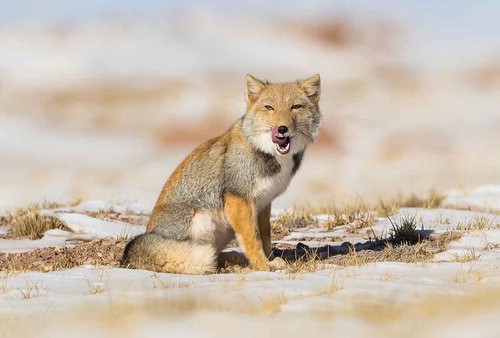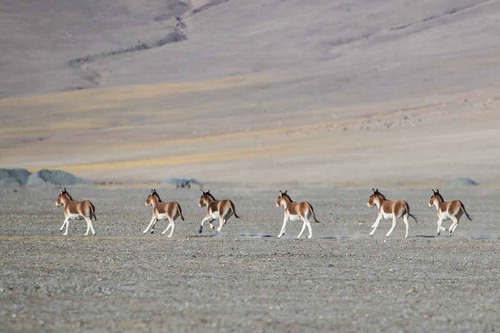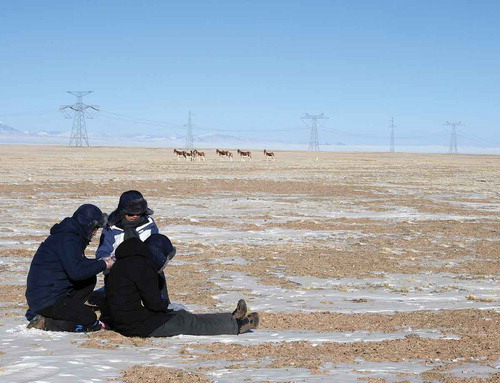ABSTRACT
The targets of China’s national park construction are to protect the authenticity and integrity of the ecosystems, and to achieve the harmonious development between humans and nature. Because of the high intensity of human activities, the authenticity of ecosystems has deviated over the past few decades. It is time to rewild the wildlife and restore the authenticity of these ecosystems. The status of rewilding wildlife in Sanjiangyuan National Park, indicating that the wildlife population, diversity and wildness have increased within the National Park. The wildlife population in the national park has been restored, with about 60,000 Tibetan antelope, 60,000 Tibetan gazelle, 36,000 Tibetan wild ass, 10,000 wild yak, and 10,000 white-lipped deer up to 2017. However, overgrazing existed on the alpine grassland with population increasing both of ungulates and livestock.
In natural landscapes undergoing land use extensification, rewilding has been proposed as a viable approach to reverse biodiversity loss through reducing human impacts. Due to human activities, the number of wildlife in the Sanjiangyuan area at the end of the last century was at its lowest point, with the Tibetan antelope population down to about 20,000. Over the past 20 years, especially since the establishment of the national park system, the number of wild life has gradually recovered and the endangered status has declined (Jiang et al. Citation2016). The photographs below illustrated the status of rewilding wildlife in Sanjiangyuan National Park which indicates that the authenticity and integrity of the ecosystems are gradually being restored.
There has been a significant increase in the number of ungulates in the Sanjiangyuan National Parkf
Due to the increasing guarantees of wildlife protection by governments at all levels of regular legal systems, the population of Tibetan antelope as well as other wildlife recovered rapidly. Investigators even witnessed Tibetan antelope freely crossing the highroad. The population of Tibetan antelope has increased to 3 times than that of 20 years ago (Cai et al. Citation2019).
Photo 1. A male Tibetan antelope (Pantholops hodgsonii) openly crosses the National Road 215 and watches the expedition team. Taken Dec. 2019 in Duoxiu, Qumalai county in the Yangtze River Source Park. Photographer: Xinquan Zhao.
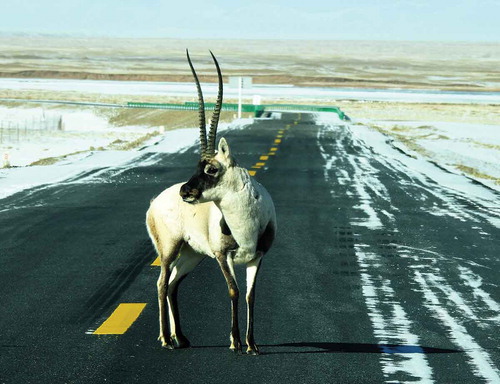
Photo 2. A herd of female Tibetan antelope (Pantholops hodgsonii) is migrating to the Hoh Xil hinterland to deliver lambs. In 2017, the number of those animals in the Sanjiangyuan National Park area has returned to 6–7 million, three times as many as two decades ago. Taken May 2020 in the Hoh Xil, Sanjiangyuan National Park. Photographer: He Fuquan.
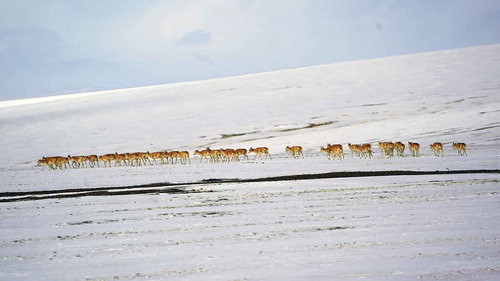
The conflict between the inhabitants and wildlife becomes more and more prominent
Can local herdsman live in harmony with Tibetan wild ass or will their livestock compete with the wildlife for herbage resources? In the core protection zone of the National Park, Tibetan wild ass and Tibetan sheep grazed in the same pasture. Do the animals live in harmony or compete for the territory with each other? To our knowledge, overloading and overgrazing existed on the alpine grassland, especially in the overlap areas of ungulates and livestock. In the Yellow River Source Park, the numbers of livestock are 4–5 times greater when comparing with ungulate wildlife counted using the standard sheep unit measurement (Shao et al. Citation2018).
Photo 3. A group of Bar-headed geese (Anser indicus) and black-necked crane (Grus nigricollis) share the same alpine wetland with domestic grazing yaks (Bos grunniens) during growing season. Local herders gradually changed from pastoral production to ecological protection. Taken July 2019 in the Longbaotan National Nature Reserve, Yushu, Qinghai Province. Photographer: Xinquan Zhao.
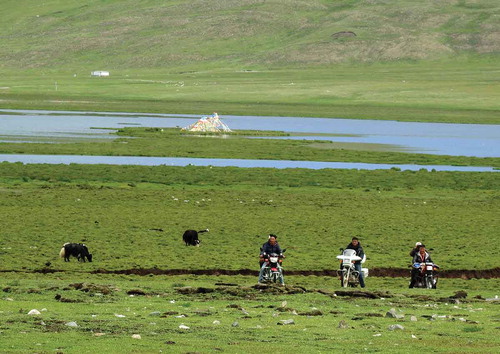
The increase in carnivore populations, making ecosystems more stable and healthy
Previously, the vast alpine grassland often faced the lack of predators and wildlife. However, now the food chain in the National Park is becoming more and more complete. The balance between herbage production and herbivores is achieved through the region’s natural regulation. In the past, landscapes such as these five wolves and one fox were extremely rare to be seen.
The wildlife become more wildness, and humans and wildlife can become more harmonious
Tibetan wild ass, with a population of 36,000, has the largest biomass in Sanjiangyuan National Park. They were not scared of the vehicles of the expedition and freely stood around us during our field sampling. They always kept a healthy distance but did not want to leave. This indicates that the quality of the ecosystem is becoming better, and that wildlife can be in harmony with humans if we are willing to protect it. We hope that humans and wildlife are permanent friends in Sanjiangyuan National Park that limiting livestock grazing to a sustainable level is a more reasonable approach if overgrazing exists.
Conclusions
With the growth of people’s ecological protection awareness and the improvement of the legislative systems, the wildlife population, food chains and wilderness in Sanjaingyuan National Park are all recovering and perfecting rapidly. The ecosystems are gradually achieving their original structure and authenticity. Sanjiangyuan National Park is becoming an ideal place for observing wildlife in Asia and even globally. Managers must understand that limiting livestock grazing to a sustainable level is a more reasonable approach if overgrazing exists. Further research on the grassland’s carrying capacity and its utilization strategy should be strengthened to provide technical support for the grassland adaptive management in Sanjiangyuan National Park.
Disclosure statement
No potential conflict of interest was reported by the authors.
References
- Cai, Z. Y., W. Qin, H. M. Gao, T. Wu, X. W. Chi, J. H. Yang, Z. Y. Miao, et al. 2019. “Species Diversity and Fauna of Mammals in Sanjiangyuan National Park.” Acta Theriologica Sinica 39 (4): 410–420. (in Chinese). doi:10.16829/j.slxb.150215.
- Jiang, Z. G., J. P. Jiang, Y. Z. Wang, E. Zhang, Y. Y. Zhang, L. L. Li, F. Xie, et al. 2016. “Red List of China’s Vertebrates.” Biodiversity Science 24 (5): 500–551. (in Chinese).
- Shao, Q. Q., X. J. Guo, Y. Z. Li, Y. C. Wang, D. L. Wang, J. Y. Liu, I. W. Fan, and F. Yang. 2018. “Using UAV Remote Sensing to Analyze the Population and Distribution of Large Wild Herbivores.” Journal of Remote Sensing 22 (3): 497–507. (in Chinese). doi:10.11834/jrs.20187267.

